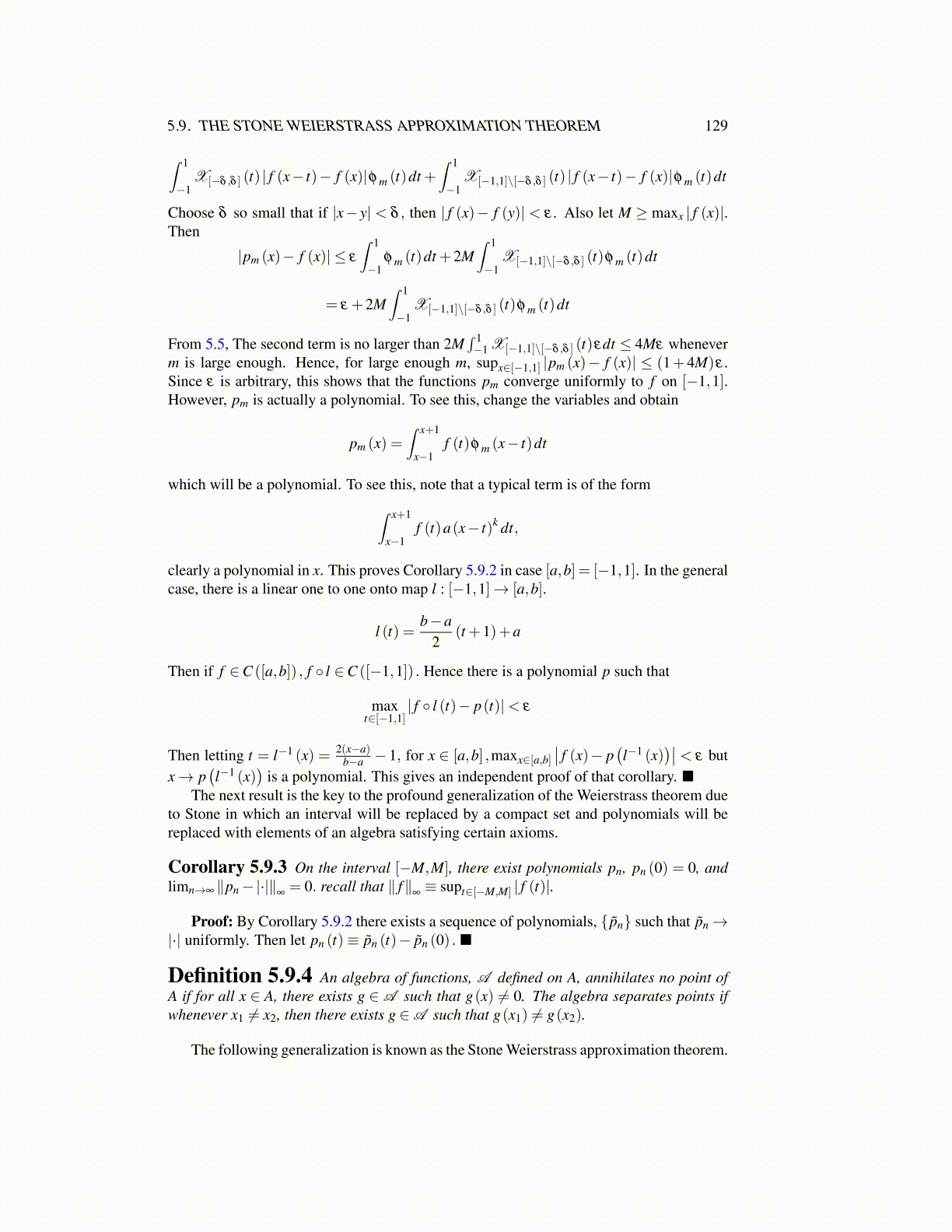
5.9. THE STONE WEIERSTRASS APPROXIMATION THEOREM 129
∫ 1
−1X[−δ ,δ ] (t) | f (x− t)− f (x)|φ m (t)dt +
∫ 1
−1X[−1,1]\[−δ ,δ ] (t) | f (x− t)− f (x)|φ m (t)dt
Choose δ so small that if |x− y| < δ , then | f (x)− f (y)| < ε . Also let M ≥ maxx | f (x)|.Then
|pm (x)− f (x)| ≤ ε
∫ 1
−1φ m (t)dt +2M
∫ 1
−1X[−1,1]\[−δ ,δ ] (t)φ m (t)dt
= ε +2M∫ 1
−1X[−1,1]\[−δ ,δ ] (t)φ m (t)dt
From 5.5, The second term is no larger than 2M∫ 1−1 X[−1,1]\[−δ ,δ ] (t)εdt ≤ 4Mε whenever
m is large enough. Hence, for large enough m, supx∈[−1,1] |pm (x)− f (x)| ≤ (1+4M)ε .Since ε is arbitrary, this shows that the functions pm converge uniformly to f on [−1,1].However, pm is actually a polynomial. To see this, change the variables and obtain
pm (x) =∫ x+1
x−1f (t)φ m (x− t)dt
which will be a polynomial. To see this, note that a typical term is of the form∫ x+1
x−1f (t)a(x− t)k dt,
clearly a polynomial in x. This proves Corollary 5.9.2 in case [a,b] = [−1,1]. In the generalcase, there is a linear one to one onto map l : [−1,1]→ [a,b].
l (t) =b−a
2(t +1)+a
Then if f ∈C ([a,b]) , f ◦ l ∈C ([−1,1]) . Hence there is a polynomial p such that
maxt∈[−1,1]
| f ◦ l (t)− p(t)|< ε
Then letting t = l−1 (x) = 2(x−a)b−a − 1, for x ∈ [a,b] ,maxx∈[a,b]
∣∣ f (x)− p(l−1 (x)
)∣∣ < ε butx→ p
(l−1 (x)
)is a polynomial. This gives an independent proof of that corollary. ■
The next result is the key to the profound generalization of the Weierstrass theorem dueto Stone in which an interval will be replaced by a compact set and polynomials will bereplaced with elements of an algebra satisfying certain axioms.
Corollary 5.9.3 On the interval [−M,M], there exist polynomials pn, pn (0) = 0, andlimn→∞ ∥pn−|·|∥∞
= 0. recall that ∥ f∥∞≡ supt∈[−M,M] | f (t)|.
Proof: By Corollary 5.9.2 there exists a sequence of polynomials, {p̃n} such that p̃n→|·| uniformly. Then let pn (t)≡ p̃n (t)− p̃n (0) . ■
Definition 5.9.4 An algebra of functions, A defined on A, annihilates no point ofA if for all x ∈ A, there exists g ∈ A such that g(x) ̸= 0. The algebra separates points ifwhenever x1 ̸= x2, then there exists g ∈A such that g(x1) ̸= g(x2).
The following generalization is known as the Stone Weierstrass approximation theorem.